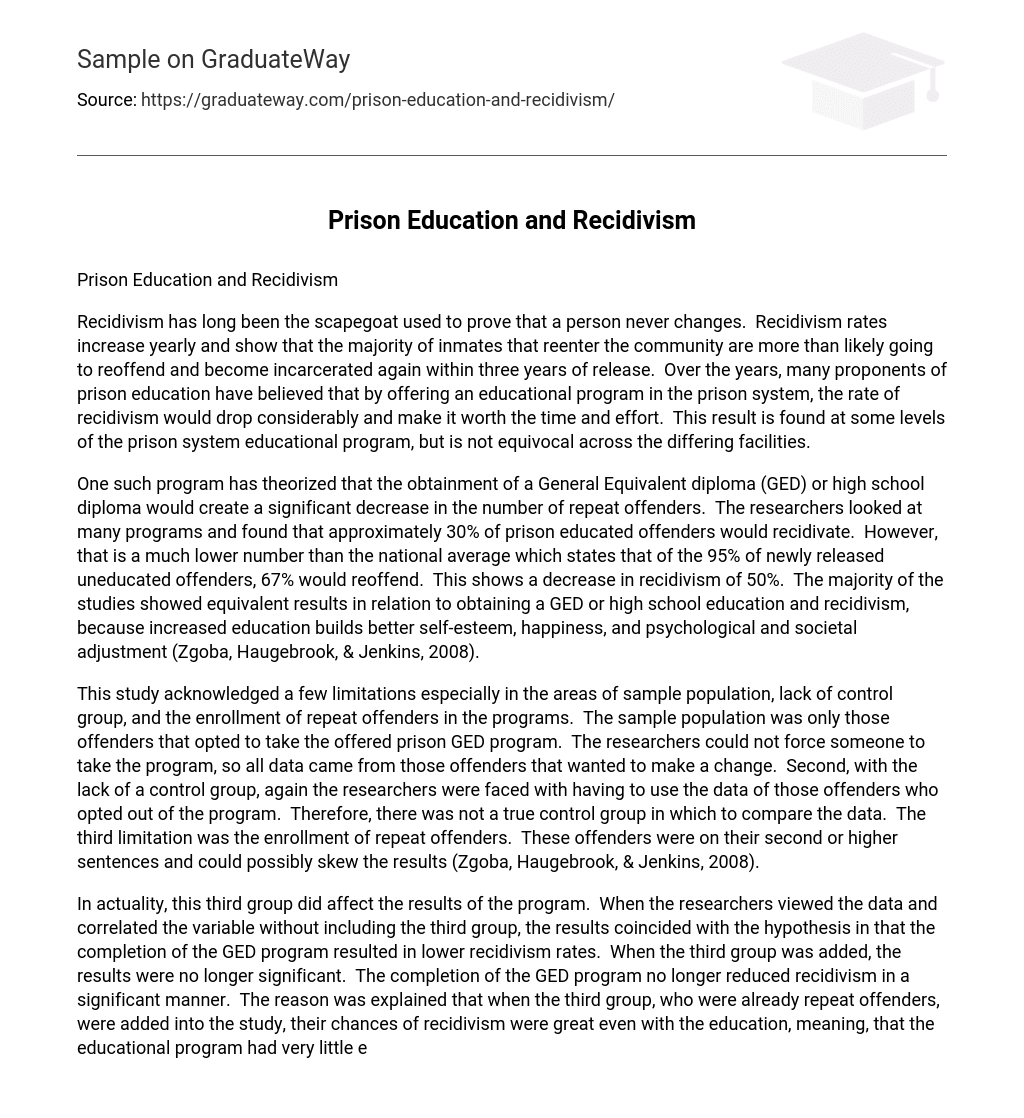Recidivism has long been the scapegoat used to prove that a person never changes. Recidivism rates increase yearly and show that the majority of inmates that reenter the community are more than likely going to reoffend and become incarcerated again within three years of release. Over the years, many proponents of prison education have believed that by offering an educational program in the prison system, the rate of recidivism would drop considerably and make it worth the time and effort. This result is found at some levels of the prison system educational program, but is not equivocal across the differing facilities.
One such program has theorized that the obtainment of a General Equivalent diploma (GED) or high school diploma would create a significant decrease in the number of repeat offenders. The researchers looked at many programs and found that approximately 30% of prison educated offenders would recidivate. However, that is a much lower number than the national average which states that of the 95% of newly released uneducated offenders, 67% would reoffend. This shows a decrease in recidivism of 50%. The majority of the studies showed equivalent results in relation to obtaining a GED or high school education and recidivism, because increased education builds better self-esteem, happiness, and psychological and societal adjustment (Zgoba, Haugebrook, & Jenkins, 2008).
This study acknowledged a few limitations especially in the areas of sample population, lack of control group, and the enrollment of repeat offenders in the programs. The sample population was only those offenders that opted to take the offered prison GED program. The researchers could not force someone to take the program, so all data came from those offenders that wanted to make a change. Second, with the lack of a control group, again the researchers were faced with having to use the data of those offenders who opted out of the program. Therefore, there was not a true control group in which to compare the data. The third limitation was the enrollment of repeat offenders. These offenders were on their second or higher sentences and could possibly skew the results (Zgoba, Haugebrook, & Jenkins, 2008).
In actuality, this third group did affect the results of the program. When the researchers viewed the data and correlated the variable without including the third group, the results coincided with the hypothesis in that the completion of the GED program resulted in lower recidivism rates. When the third group was added, the results were no longer significant. The completion of the GED program no longer reduced recidivism in a significant manner. The reason was explained that when the third group, who were already repeat offenders, were added into the study, their chances of recidivism were great even with the education, meaning, that the educational program had very little effect on repeat offenders and would not help reduce recidivism in that specific group. (Zgoba, Haugebrook, & Jenkins, 2008).
Another factor that could have led to a less than significant outcome was the fact, that many employers now look for people with at least some college education if not a degree. This would again place those offenders with only a GED at the bottom of the list in regard to job obtainment. This lack of work opportunity and still a lack of education could very easily push the offender back into a life of crime (Zgoba, Haugebrook, & Jenkins, 2008).
Since this study, others have looked into not only offering GED or high school diploma programs, but also college programs to give the offenders an even better chance of success and a continued reduction in recidivism. Included in these programs would be interpersonal skills, life skills, and strategies to let go creatively rather than in a deviant way. The studies have shown that by offering these higher education or vocational classes improves the general population behaviors of those who attend the programs. Maintaining good behavior is a requirement to stay in the program. Findings from these incorporated programs show a lower recidivism rate as well as a lower parole and probation revocation rate. This leads to lower crime statistics, by building up and education the offender rather than just making him/her do the time (Vacca, 2004).
Another factor that influences this decrease in recidivism and an increased enrollment in these programs was the attitudes of those in authority especially the instructors. Keeping teaching staff is hard, though due to lack of funding for these programs. This facet needs to be studied more in relation to the educational level and the recidivism of these offenders. Many believe that the cost is worth it in relation to the crime rate and cost to house an inmate for one year. The opposition however, views prison educational programs as unjust. There are many that believe the inmates should not have the ability to obtain higher education at the expense of the taxpayer, but either way the taxpayer pays (Case, nd; Vacca, 2008).
Until the 1990’s inmate could qualify for federal aid to attend college, but that was revoked due to the public outcry. What is true is that the correlation between the level of education and the rate of recidivism is positive. One deters the other. Education deters the chances of returning to crime. This is not an end all, and more needs to be discerned, but in honesty, educational programs help to facilitate a true rehabilitative atmosphere, and reduce repeat offenders, making the communities safer and happier.
References
Case, P. (n.d.). Predicting risk time and probability: An assessment of prison education and recidivism. Paper presented at the meeting of the American Sociological Association.
Vacca, J.S. (2004). Educated prisoners are less likely to return to prison. Journal of Correctional Education. 55(4). pp. 297-305. Retrieved December 15, 2008, from Research Library database.
Zgoba, K.M., Haugebrook, S., & Jenkins, K. (2008). The influence of GED obtainment on inmate release outcome. Criminal Justice and Behavior. 35. pp. 375. Retrieved December 15, 2008, from Research Library database.





